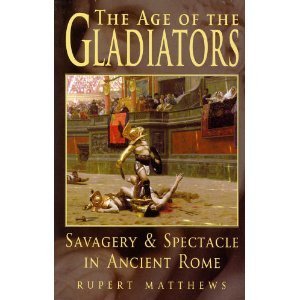Rupert Matthews's Blog, page 25
January 23, 2014
Shenaningans at the feasts of Caligula
The first emperor to become notorious for the debauchery of his dinners was Caligula. Caligula came to power in AD37 at the age of 24. His reign began well, but he then became seriously ill and fell into a coma. When he recovered Caligula was a changed man, many thought he was mad. He took his sister Drusilla as wife, and when she died picked up a notoriously depraved prostitute named Caesonia. Caligula used his guards to assasinate anyone who displeased him, or sent men to trial in front of bribed judges to be whipped, stripped of their property or executed.
If he tired of Caesonia, Caligula would invite couples to dinner. The man would be left outside while the wives were brought in to enjoy an intimate time with the emperor. Sometimes Caligula was interested only in conversation, but he could force himself on the women with the threat of having their husbands executed if they refused. When Caligula next met the husband, he often engaged him in lighthearted banter on the subject of his wife’s beauty and performance in bed.
from THE AGE OF GLADIATORS by Rupert Matthews.
Buy your copy HERE
 http://www.amazon.co.uk/Age-Gladiator...
http://www.amazon.co.uk/Age-Gladiator...
If he tired of Caesonia, Caligula would invite couples to dinner. The man would be left outside while the wives were brought in to enjoy an intimate time with the emperor. Sometimes Caligula was interested only in conversation, but he could force himself on the women with the threat of having their husbands executed if they refused. When Caligula next met the husband, he often engaged him in lighthearted banter on the subject of his wife’s beauty and performance in bed.
from THE AGE OF GLADIATORS by Rupert Matthews.
Buy your copy HERE
 http://www.amazon.co.uk/Age-Gladiator...
http://www.amazon.co.uk/Age-Gladiator...
Published on January 23, 2014 01:45
January 20, 2014
The First Arena of Ancient Rome
The First Arena
The first arena built in Rome specifically for gladiator fights was erected in 29bc by the politician Titus Satilius Taurus. Because he wanted to flatter the emperor Augustus, Taurus had the name of Augustus carved over the entrance. It worked, Taurus had a long and distinguished career.
from ACTION FILES - GLADIATORS by Rupert Matthews
Buy your copy HERE
 http://www.amazon.co.uk/Gladiators-St...
http://www.amazon.co.uk/Gladiators-St...
The first arena built in Rome specifically for gladiator fights was erected in 29bc by the politician Titus Satilius Taurus. Because he wanted to flatter the emperor Augustus, Taurus had the name of Augustus carved over the entrance. It worked, Taurus had a long and distinguished career.
from ACTION FILES - GLADIATORS by Rupert Matthews
Buy your copy HERE
 http://www.amazon.co.uk/Gladiators-St...
http://www.amazon.co.uk/Gladiators-St...
Published on January 20, 2014 04:25
January 16, 2014
Reed Boats of Ancient Egypt
Reed Boats of Ancient Egypt
Wood was rare and expensive in Egypt. Most smaller boats were made by tying together bundles of reed that grew alongside the Nile. These smaller boats were quick and cheap to build so they were used by fishermen.
from ACTION FILES - ANCIENT EGYPT by Rupert Matthews
Buy your copy HERE
 http://www.amazon.co.uk/Action-Files-...
http://www.amazon.co.uk/Action-Files-...

Wood was rare and expensive in Egypt. Most smaller boats were made by tying together bundles of reed that grew alongside the Nile. These smaller boats were quick and cheap to build so they were used by fishermen.
from ACTION FILES - ANCIENT EGYPT by Rupert Matthews
Buy your copy HERE
 http://www.amazon.co.uk/Action-Files-...
http://www.amazon.co.uk/Action-Files-...
Published on January 16, 2014 00:56
January 14, 2014
German War Plans 1916
In the spring of 1916 von Falkenhayn, commander of the German army, studied the Russian front. The German and Austrian armies were now deep inside Russia. They were separated from their homeland by hundreds of kilometres of poor roads. Falkenhayn decided that supplying a major offensive would be impossible.
from 100 FACTS ON WORLD WAR I by Rupert Matthews
Buy your copy HERE
 http://www.amazon.co.uk/World-War-100...
http://www.amazon.co.uk/World-War-100...
from 100 FACTS ON WORLD WAR I by Rupert Matthews
Buy your copy HERE
 http://www.amazon.co.uk/World-War-100...
http://www.amazon.co.uk/World-War-100...
Published on January 14, 2014 02:21
January 12, 2014
The Heirs to Romulus - First King of Rome
Romulus left no children, so his place as King of Rome was taken by Numa Pompilius, a famous Sabine philosopher. Numa said that he was ordered by the goddess Egeria (see page 178) to make peace with neighbouring cities.
from "1000 Facts about Ancient Rome" by Rupert Matthews
Buy your copy HERE
 http://www.amazon.co.uk/1000-Facts-An...
http://www.amazon.co.uk/1000-Facts-An...
Published on January 12, 2014 04:07
January 10, 2014
NEW EBOOK - Man from the North East

Women, murder, suicide, assault infidelity and the abduction of children shape, colour and test the loyalties of George, a family man.
A compelling tale of a determined young man seeking his fortune in 1930's London. George, with an elementary education, is full of ambitions but life takes a different direction. He meets colourful ladies; and Cockneys teach him a trade. Murder, suicide, infidelity, abduction and war test his mettle. Although content with the outcome and with a family and little money, he is still set on furthering his education, wanting to put letters after his name.
About the Author
Beatrice Holloway, B.A., B.Ed. has always been interested in history, especially when new information clarifies, confirms or questions the past. With the help of a lottery grant she has written and had produced a play; an eighteenth century scandal for which she was awarded a Certificate of Merit for Contributions to the Arts.
Buy your copy HERE
http://www.smashwords.com/books/view/...

Published on January 10, 2014 01:18
January 7, 2014
St David of Wales
[image error]
The local scholar, St David, established the pattern of Welsh Christianity in the late 6th century. His legacy was immense, but was largely swept away when the Pope re-established control of Welsh Christianity. David is now the patron saint of Wales.
The various tales about St David were collected together in the 11th century by the monk Rhigyfarch. Unfortunately for later scholars, Rhigyfarch was a devoted admirer of St David.
Rhigyfarch was so keen for readers of his ‘Life’ to admire St David, that he inserted all sorts of legends and fables which served to inflate the importance of the saint. Tales of miracles and divine intervention were included, even when they were lifted from older biographies of other saints. Amid all this adulation and make believe it is difficult to discern exactly what is true and what is false.
Undoubtedly, however, St David was born in the mid to late 6th century in Ceredigion along the west coast of Wales. Carrying the Welsh form of his name, Dewi, David at first had an upbringing as good as any that could be expected at the time. His father, Sant, was the ruler of Ceredigion. His minor court would have been a strange mix of late Roman learning, barbaric military might and Celtic artistic beauty.
Early in life, Dewi showed a skill for book learning and was sent to Llanilltud Fawr to be educated. During his teens, Dewi showed that he was not only a remarkably bright scholar but also an ascetic of unusual devotion. For David there was no time for worldly luxuries such as he had known as a child. Fine clothes and fine food were merely a distraction from the contemplation of God and the study of Holy Scripture.
It was only some 30 years since Gildas, a noted scholar of his own generation, had railed against the sins of the rulers of his day. The writings of Gildas were highly popular and influenced the thoughts of many. When Gildas contrasted the failure of modern British rulers to unite against the English attacks with the glories of an earlier period, people listened. When he denounced the sins and luxuries of rulers and said they sapped the will to rule wisely, Gildas struck a popular chord.
Young Dewi grew up in a world shaped by the thinking of Gildas and his contemporaries. Indeed Gildas may have still been alive when Dewi wen to Llanilltud Fawr. This set the scene for Dewi’s enormous success as an advocate of the monastic ideal. Dewi travelled through the lands of the Britons calling on holy men to withdraw from the sins of the world to live in monasteries. There they could devote themselves to study and prayer without the distractions which were proving so disastrous to the British.
After founding monasteries in such places as Bath and Chester, Dewi became Bishop of Menevia. This Roman town in the heart of Ceredigion was dying as an urban centre, but Dewi made it a seat of learning. According to legend Dewi chose the site as his mother, Non daughter of King Cynyr, grew up there. On a nearby hill was a small chapel founded by St Patrick on his way to convert the Irish. Non had worshipped there as a teenager and Dewi made this secluded place the seat of his ministry.
By this time Dewi was the acknowledged leader of British Christianity, welcoming bishops from Scotland and Ireland to his remote church. He organised two synods, one at the unidentified Roman town of Lucas Victoriae and the second at Llanddewi Brefi. The second and much larger synod set British Christianity on the same pattern as that of Ireland. Monasteries became the heart of Church life, with bishops fulfilling a more minor pastoral role.
Back at his isolated church at Menevia, Dewi lived out his final years in severe ascetic conditions. His life and works became models for others to emulate. After his death Menevia was renamed St David’s. It continued to decline as a town, and now has barely half a dozen streets. But it is still the seat of the bishopric and site of a fine cathedral.

Published on January 07, 2014 02:15
January 4, 2014
Whose death is announced by the phantom drummer of Airlie?
On rare and infrequent occasions the sound of a fervently beaten drum echoes around Cortachy Castle in Aberdeenshire. The sound heralds death, but not for the person who hears it.
The legend of the phantom drummer of Airlie dates back many centuries to a time of clan feuds and frequent violence. The Earls of Airlie, chiefs of the Clan Ogilvy, were as proud and likely to turn to violence as any of the clan chiefs, especially if their traditional enemies, members of Clan Campbell, were involved. It was one of Ogilvys of those days who killed the drummer who still haunts the family.
Exactly what you are told the drummer had done to raise the anger of the Earl of Airlie depends on whom you talk to. According to one legend the drummer was watchman on the castle ramparts, but he took the money of the Campbell so that he would not sound his drum to give the alarm during a raid. When the Earl found out about the drummer’s treachery, he stuffed the man into his own drum and threw him to his death from the castle battlements. Another legend recounts that the drummer was actually a Campbell messenger sent to deliver a demand for surrender. The drummer’s death by being flung from the battlements was the answer of the Clan Ogilvy. A third version of the legend holds that the drummer became the lover of the Lady Airlie while the Earl was absent and that he was thrown from the battlements on the Earl’s return.
But however he met his death, the drummer faced it bravely. All legends agree that before being flung to his death the man cursed the Earl and all his family. The drummer then promised to haunt the Airlies for all time, and to return from the dead to accompany the cursed ones on their journey to death.
Sure enough, the legends go, the phantom drummer was seen a short time later beating out a tattoo of mad violence as he marched around the tower from which he had been thrown to his death. Next morning the Earl dropped dead. From that day to this, whenever a member of the Ogilvy family died the sound of drumming is heard around Cortachy Castle to announce the death of yet another of the cursed family.
One respectable Victorian lady recorded how she had been invited to stay at Cortachy Castle in the time of the 7th Earl. During the night she heard a strange throbbing noise which, when she opened her window, became clearer as the sound of a drum being played rapidly and violently. Knowing nothing about the old legend, the woman asked over breakfast who could have been playing a drum so late at night. She said the Earl turned pale and hurriedly changed the subject. Unknown to the guest, Lady Airlie was ill at the time and died a short time later. The 7th Earl’s death is said to have been heralded by the drummer who followed a shooting party out on to the moors of the estate the day before the Earl died.
The 8th Earl met his end while on active service with the 12th Royal Lancers in the Boer War. No phantom drumming is recorded at the time of his death, but any drumming sound may have passed unremarked in a military camp in which dozens of drums and drummers were to be found. The 9th Earl died in the USA, but on the night he died Lady Dalkeith, who was staying in Cortachy Castle, was awoken by the sound of the phantom drummer. After the news of the death of the Earl arrived, Lady Dalkeith checked the timings and found she had been awoken about one hour before the sad event. The death of the 12th Earl in 1968 seems to have been untroubled by the phantom drummer. At least, nobody reported hearing the ghostly spectre march about the walls of Cortachy Castle.

The legend of the phantom drummer of Airlie dates back many centuries to a time of clan feuds and frequent violence. The Earls of Airlie, chiefs of the Clan Ogilvy, were as proud and likely to turn to violence as any of the clan chiefs, especially if their traditional enemies, members of Clan Campbell, were involved. It was one of Ogilvys of those days who killed the drummer who still haunts the family.
Exactly what you are told the drummer had done to raise the anger of the Earl of Airlie depends on whom you talk to. According to one legend the drummer was watchman on the castle ramparts, but he took the money of the Campbell so that he would not sound his drum to give the alarm during a raid. When the Earl found out about the drummer’s treachery, he stuffed the man into his own drum and threw him to his death from the castle battlements. Another legend recounts that the drummer was actually a Campbell messenger sent to deliver a demand for surrender. The drummer’s death by being flung from the battlements was the answer of the Clan Ogilvy. A third version of the legend holds that the drummer became the lover of the Lady Airlie while the Earl was absent and that he was thrown from the battlements on the Earl’s return.
But however he met his death, the drummer faced it bravely. All legends agree that before being flung to his death the man cursed the Earl and all his family. The drummer then promised to haunt the Airlies for all time, and to return from the dead to accompany the cursed ones on their journey to death.
Sure enough, the legends go, the phantom drummer was seen a short time later beating out a tattoo of mad violence as he marched around the tower from which he had been thrown to his death. Next morning the Earl dropped dead. From that day to this, whenever a member of the Ogilvy family died the sound of drumming is heard around Cortachy Castle to announce the death of yet another of the cursed family.
One respectable Victorian lady recorded how she had been invited to stay at Cortachy Castle in the time of the 7th Earl. During the night she heard a strange throbbing noise which, when she opened her window, became clearer as the sound of a drum being played rapidly and violently. Knowing nothing about the old legend, the woman asked over breakfast who could have been playing a drum so late at night. She said the Earl turned pale and hurriedly changed the subject. Unknown to the guest, Lady Airlie was ill at the time and died a short time later. The 7th Earl’s death is said to have been heralded by the drummer who followed a shooting party out on to the moors of the estate the day before the Earl died.
The 8th Earl met his end while on active service with the 12th Royal Lancers in the Boer War. No phantom drumming is recorded at the time of his death, but any drumming sound may have passed unremarked in a military camp in which dozens of drums and drummers were to be found. The 9th Earl died in the USA, but on the night he died Lady Dalkeith, who was staying in Cortachy Castle, was awoken by the sound of the phantom drummer. After the news of the death of the Earl arrived, Lady Dalkeith checked the timings and found she had been awoken about one hour before the sad event. The death of the 12th Earl in 1968 seems to have been untroubled by the phantom drummer. At least, nobody reported hearing the ghostly spectre march about the walls of Cortachy Castle.

Published on January 04, 2014 02:04
December 21, 2013
Trilobites were the most numerous arthropods
The word “trilobite” means “three parts”. It was given to creatures such as Conocoryphe because the body is always divided into three parts, a head, a body and a tail. Trilobites first lived about 550 million years ago and by 500 million years ago were among the most numerous animals.
From "100 Things to knowa bout Prehistoric Life" by Rupert Matthews
Buy your copy at Amazon or a bookshop
 http://www.amazon.co.uk/Prehistoric-L...
http://www.amazon.co.uk/Prehistoric-L...

From "100 Things to knowa bout Prehistoric Life" by Rupert Matthews
Buy your copy at Amazon or a bookshop
 http://www.amazon.co.uk/Prehistoric-L...
http://www.amazon.co.uk/Prehistoric-L...
Published on December 21, 2013 01:23
December 19, 2013
Gladiator Fun Fact
Spartacus made his prisoners fight as gladiators to amuse the ex-gladiators in his army.
from "100 Facts about Gladiators" by Rupert Matthews.

http://www.amazon.co.uk/Gladiators-10...

from "100 Facts about Gladiators" by Rupert Matthews.

http://www.amazon.co.uk/Gladiators-10...

Published on December 19, 2013 01:50



